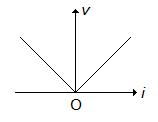ECE :: Electronic Devices and Circuits
-
Hall effect can be used
-
The v-i characteristic of an element is shown in below figure the element is

-
The probability giving distribution of electrons over a range of allowed energy levels is known as
-
It is required to trace the output characteristics of a CE bipolar transistor on a CRO screen. The proper method is
-
The resistivity of ferrites is
-
A JFET
-
In monostable multivibrator
|
A.
apply the voltage drop across collector resistance to Y input, disconnect sweep generator and apply VCE to X input
|
|
B.
apply voltage drop across collector resistance to Y input
|
|
C.
apply VCE to X input
|
|
D.
apply VCE to Y input, disconnect the sweep generator and apply voltage drop across collector resistance to X input
|


 Whatsapp
Whatsapp
 Facebook
Facebook





